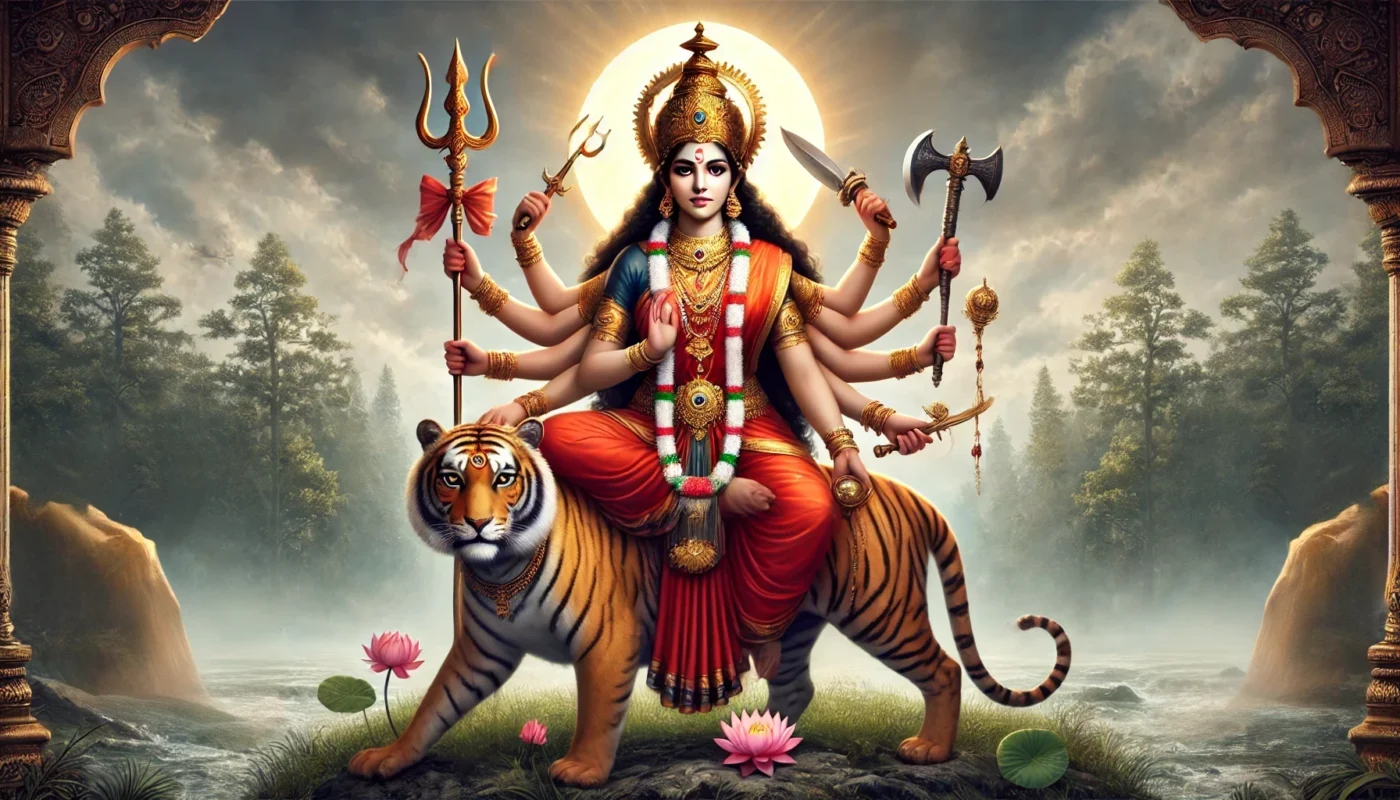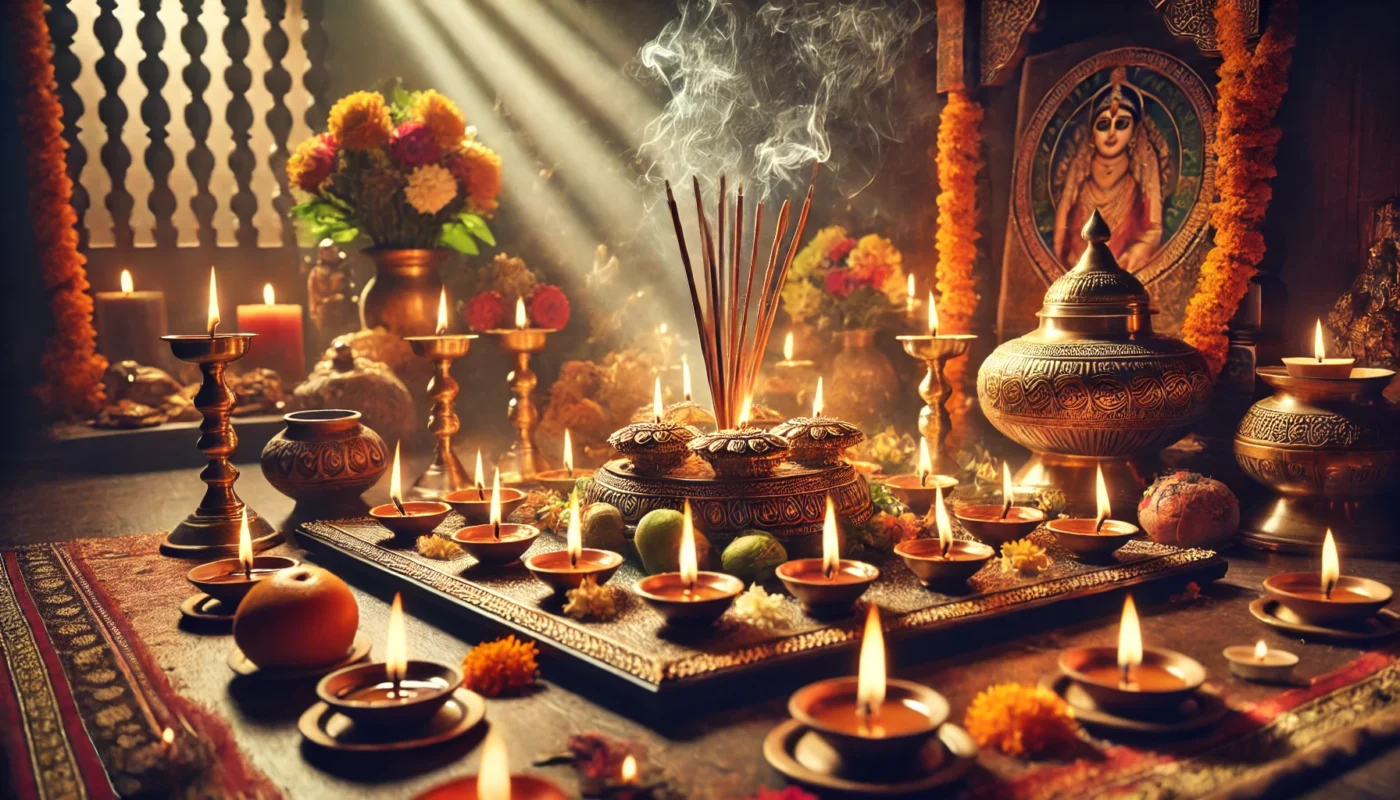Maa Chandraghanta is worshipped on the third day of Navratri and is prayed for her immense courage, grace, and warrior-like nature. She is known as the goddess of peace, tranquility, and prosperity, yet she symbolizes fearlessness and strength in the face of evil. In this form, Goddess Durga is portrayed with a half-moon shaped like a bell on her forehead, giving her the name “Chandraghanta.”
In this article, we will explore the significance, appearance, legend, and rituals related to this third form of Goddess Durga.
Table of Contents
Who is Maa Chandraghanta?

This form represents the married form of Goddess Parvati, after her union with Lord Shiv. When Parvati married Shiva, she adorned herself with the half-moon (Chandra) on her forehead and took a bell (ghanta) to kill a demon named Jatukasur. Her form is fierce, yet she provides peace and calmness to her devotees.
She rides a tigress, carrying various weapons in her ten arms, indicating her ability to destroy all forces of negativity and evil.
The Story of Maa Chandraghanta
According to Shiv Purana, Parvati, after marrying Lord Shiva, faced a new challenge when demon Tarkasur sent Jatukasur, a bat-demon, to attack Kailasa. While Shiva was in his deep meditation, Parvati, initially fearful, was reminded by Shiva of her inner power as Shakti, the mother of the universe.
After remembering her powers she prepared for battle. With the moon god Chandradev illuminating the battlefield, Parvati summoned a pack of wolves to fight the demon’s bat army. Using a ghanta (bell) to disperse the bats, she finally defeated Jatukasura by striking him with her sword and bell.
This fierce form of Parvati is then named Chandraghanta by Brahma Ji, symbolizing courage and strength, reminding women that they are never helpless.
Symbolism of Maa Chandraghanta

This fierce form of maa symbolizes both courage and compassion. She inspires devotees to face their fears and challenges with bravery while maintaining inner peace and harmony. Her ten arms, each holding a weapon, represent her ability to protect her devotees from all directions. The lion or tiger she rides symbolizes her mastery over fear and her readiness to fight for justice.
Significance of Worshipping Maa
Maa Chandraghanta is a symbol of divine grace, courage, and prosperity. Her worship on the third day of Navratri helps devotees remove obstacles in their lives and attain spiritual awakening. She grants her devotees the strength to fight their inner and outer demons, while also blessing them with peace and prosperity.
- Protection from Evil:
Maa protects her devotees from evil forces and negative energies. Her powerful warrior form assures them of safety and security in all aspects of life. - Spiritual Upliftment:
Worshipping her helps devotees progress on the path of spirituality, leading to inner calm and mental clarity. Her blessings foster a deep sense of peace and devotion.
Rituals to Worship Maa Chandraghanta

The third day of Navratri is dedicated to Maa Chandraghanta, and her puja is performed with great devotion and care. The rituals are meant to invoke her powerful presence and seek her blessings for strength and peace.
- Prepare the Puja Area:
- Clean the space where the puja will be performed and purify it with Ganga Jal (holy water). Install an image or idol of Maa Chandraghanta.
- Offer Flowers and Prasad:
- Offer red flowers, as they are considered auspicious for Maa Chandraghanta. Prepare sweet dishes like kheer or halwa as prasad.
- Light a Lamp and Incense:
- Light a ghee lamp (diya) and burn incense sticks to purify the atmosphere.
- Chant Her Mantras:
- Chant the following mantras to invoke her blessings:
- Dhyana Mantra:
पिण्डजप्रवरारूढा चण्डकोपास्त्रकैर्युता।
प्रसादं तनुते मह्यं चंद्रघण्टेति विश्रुता॥
“I meditate upon Goddess Chandraghanta, who is seated on a fierce tiger, equipped with deadly weapons, and is known for her grace and mercy.”
Beej Mantra: ॐ देवी चन्द्रघण्टायै नमः।
- Perform Aarti:
- Perform the aarti with a pure heart, offering light and devotion to the goddess.
- Offer Prasad and Distribute:
- Offer the prepared prasad to Maa Chandraghanta and then distribute it among family members and friends.
Maa Chandraghanta’s worship on the third day of Navratri helps devotees gain courage, face adversities, and live a life of balance and peace. By performing her rituals with devotion, one can invoke her blessings for protection, prosperity, and spiritual growth.







